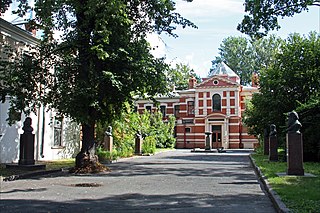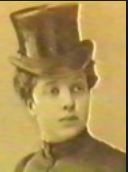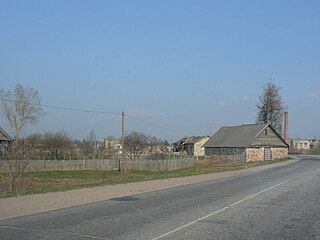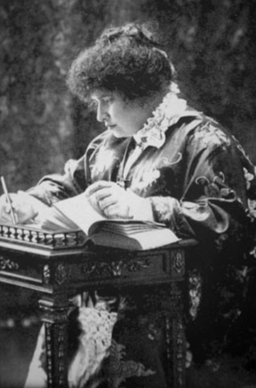
Porcelain is a ceramic material made by heating raw materials, generally including kaolinite, in a kiln to temperatures between 1,200 and 1,400 °C. The greater strength and translucence of porcelain, relative to other types of pottery, arises mainly from vitrification and formation of the mineral mullite within the body at these high temperatures. End applications include tableware, decorative ware such as figurines, and in technology and industry such as electrical insulators and laboratory ware.

Yulii Borisovich Khariton, also known as YuB,, PhD, was a Russian physicist who was a leading scientist in the former Soviet Union's program of nuclear weapons.

Kuskovo was the summer country house and estate of the Sheremetev family. Built in the mid-18th century, it was originally situated several miles to the east of Moscow but now is part of the East District of the city. It was one of the first great summer country estates of the Russian nobility, and one of the few near Moscow still preserved. Today the estate is the home of the Russian State Museum of Ceramics, and the park is a favourite place of recreation for Muscovites.

The Ivanovo State University of Chemistry and Technology or ISUCT (ИГХТУ) is a public university located in Ivanovo, the administrative center of Ivanovo Oblast, Russia. Research priorities of the ISUCT are concentrated in chemical technology, chemistry and engineering.

The State Russian Museum, formerly the Russian Museum of His Imperial Majesty Alexander III, on Arts Square in Saint Petersburg, is the world's largest depository of Russian fine art. It is also one of the largest art museums in the world with total area over 30 hectares. In 2021 it attracted 2,260,231 visitors, ranking second on list of most-visited art museums in the world.

The Saint Petersburg Mosque, when opened in 1913, was the largest mosque in Europe outside Turkey, its minarets 49 meters in height and the dome is 39 meters high. The mosque is situated in downtown St Petersburg. It can accommodate up to five thousand worshippers.

Isaak Izrailevich Brodsky was a Soviet painter whose work provided a blueprint for the art movement of socialist realism. He is known for his iconic portrayals of Lenin and idealized, carefully crafted paintings dedicated to the events of the Russian Civil War and Bolshevik Revolution.

Princess Vera Ignatievna Gedroits was a Russian doctor of medicine and author. She was the first woman military surgeon in Russia, the first woman professor of surgery, and the first woman to serve as a physician to the Imperial Court of Russia.
Lev Shcherba was a Russian Empire and Soviet linguist and lexicographer specializing in phonetics and phonology.

Georg Wilhelm Timm, also known as Vasily Fyodorovich Timm was a Baltic-German painter, lithographer and ceramic designer, known for his genre and battle scenes. He was also the publisher of the Russian Art Gazette.

The Imperial Society for the Encouragement of the Arts was an organization devoted to promoting the arts that existed in Saint Petersburg from 1820 to 1929. It was the oldest society of its kind in Russia. Until 1882 it was called the "Society for the Encouragement of Artists". After 1917, it became the "All-Russian Society for the Encouragement of the Arts".

Olga Rapay-Markish was one of the best-known Ukrainian ceramicists of her era. She is especially noted for her large decorative works on buildings throughout Kyiv. Previous to her architectural decoration, she worked as a ceramicist at the Kyiv Experimental Ceramic Art Factory, where she was known for her delicate figurines as well as her paintings on china and dishware.

The Institute of Experimental Education in St Petersburg is one of the oldest scientific establishments in Russia. It was founded by Alexander of Oldenburg in 1888 along the lines of Louis Pasteur's Pasteur Institute. It was here that Pavlov did much of his groundbreaking physiological research.

Countess Maria Nirod was a maid of honour in the imperial court of Tsar Nicholas and Alexandra of Russia. After her husband's death, she trained as a surgical nurse and assisted in the surgery of Dr. Vera Gedroits, who became her life partner. After serving as a nurse in World War I and during the Russian Revolution, she fled with her children to Kiev. She served as a surgical nurse in Kiev until Gedroits' death and later ran a pharmacy which provided medications to the poor.
Vita Buivid is a Ukrainian-born research-based contemporary artist and photographer living in Amsterdam.

Kikerino is a village in the Volosovsky District of the Leningrad Oblast. It is the administrative centre of the Kikerinsky Rural Settlement.

Art Nouveau is an international style of art, architecture and applied arts, especially the decorative arts, that was most popular between 1893 and 1910. In the Russian language it is called Art Nouveau or Modern.

Kateryna Skarzhynska née von Reiser was a Ukrainian noblewoman, philanthropist, and collector of folklore. She established the first private museum in Ukraine to house her collection of artifacts and was particularly known for her collection of pysanky, Easter eggs decorated with Ukrainian folk art. Born in Lubny to the von Reiser family, which had a long history of military service to the Russian Tsars, she was educated at home, studying in her parents' library and with select tutors. After her father died in 1859, together with her mother, brother, and maternal grandmother she moved to the Lodygyn/Lodigine family estates in the Tver province of the Russian Empire, near Moscow. There at the age of 14, von Reiser established a school for the former serfs of the estate and a public hospital.

Osman Nuri-Asan oğlu Aqçoqraqlı, also written as Aqchoqraqli or Akchokrakli, was a Crimean Tatar writer, journalist, historian, archaeologist, ethnographer, and teacher.
Anatoly Leopoldovich Yakobson was a Soviet archaeologist, historian of art and architecture.



















